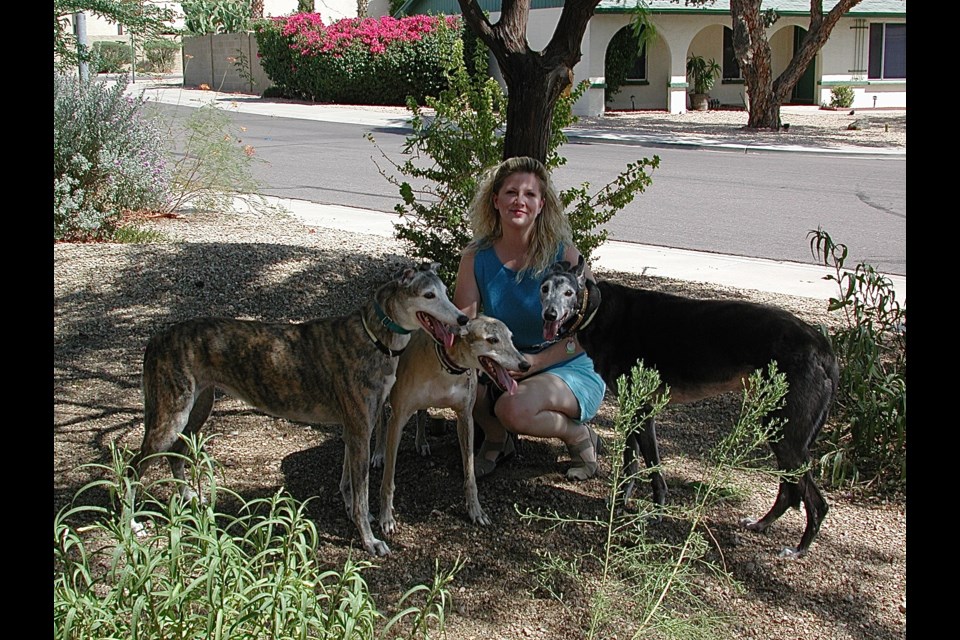In Arizona and other hot climates, we frequently hear caution to watch out for pavement that is too hot for a dog’s paws. It is said that if it is too hot for you to stand on the pavement, it is too hot for your dog. But did you know that hot temperatures during dog training and behavior modification can trigger anxiety and cause an increase in the stress hormone cortisol, which can exacerbate anxiety symptoms?
Dogs use more energy to cool down, which reduces the amount of glucose available during training (a critical chemical for learning as well as cooling down). Playtime for a dog in hot weather is quite different than a training session in hot weather where stressors are used to facilitate a change in behavior. It is assumed that dogs are in less stress during playtime as they are in more control of how long to play and when to rest, and they generally have their own activity agenda.
A normal adaptation process for a dog when exposed to psychological stress triggers is as follows:
1. Initial alarm phase - fight or flight.
2. Resistance phase - try to shake it off.
3. Recovery phase - resume normal breathing, slow heart rate, cool down and rest.
Examples of physiological changes dogs experience due to heat exposure:
- Increased heart rate.
- Increased breathing/panting (trying to cool down).
- Increased muscle tension.
- Increased blood pressure.
- Increased blood sugar.
- Appetite suppression (blood flow goes from skin and intestines to muscles for action making positive reinforcement treat taking more difficult if even possible).
- Inability to concentrate on complex tasks (focus is all on instinctive running away or fighting back), lack of impulse control and lowered threshold (dog is more likely to bite or fight).
Not only are dogs in more physiological stress simply because of the heat itself, but then we add the stressors that may occur during training. Consider learning leash work or heeling, which is an impulse control task that is counter to a dog’s preference of how he would like to walk. Let’s add a psychological stressor to that in the form of other dogs, cars, bicycles, joggers, people in general, etc., some or all of which cause dogs to react with frustration, arousal, fear or even aggression.
When working leash reactivity, triggering the dog is necessary to understand the cause and effect of the behaviors in question. Repetitive triggering may be required to establish the desired alternative behaviors. Excessive heat is detrimental not only to the training effectiveness, but to the health of the dog. Training in the heat may do more harm than good and is contrary to the goals we are trying to achieve. Accordingly, trying to work to resolve anxiety or aggression in the heat is counterproductive and ill-advised as the alternate behaviors we are seeking to resolve the dog’s conflict may not be achievable.
In addition, leash training in the heat can be difficult because we often trigger frustration for the dog. We are trying to teach the dog to walk on a loose leash and focus on the handler which creates conflict, even when we are using positive reinforcement. Often, dogs simply tire and try to enter the recovery phase before the behavior is learned.
Working dogs used as arson, police and service animals go through intensive training that surpasses any kind of training afforded a "pet" both in skill set and environmental acclimation. Pets simply cannot handle the heat and benefit from training intended to help them.
Dogs should not be worked outside when the temperature exceeds 90 degrees and the humidity exceeds 15%. They simply cannot adequately cool down, which inhibits their ability to learn and increases their overall stress. If you are going to train your dog, it must be done as early in the morning as possible when the pavement is cool and the temperature is lowest.
Sam Freeman, CPDT-KSA, is the president and owner of Pet Behavior Solutions and Edu-Care for Dogs. She is the creator of the Core Behavior Assessment, which is the behavior evaluation program used by many animal shelters and animal control agencies in Arizona. Freeman is certified through the Certification Council for Professional Dog Trainers and has completed specialized education and training in psychology, learning theory, ethology, family counseling, behavior modification techniques, aggression, canine and feline behavior issues, and grief counseling.



